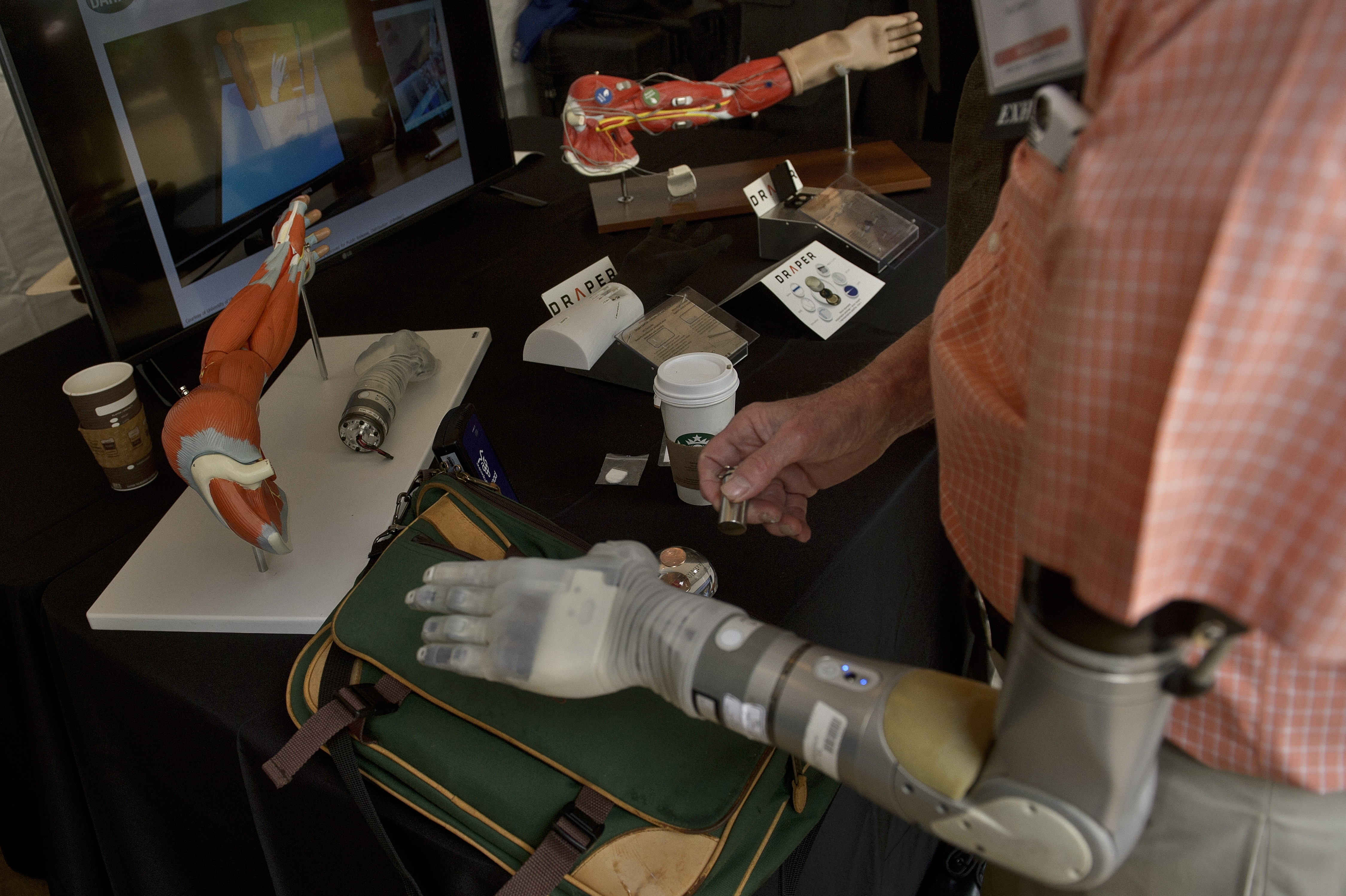
by Thomas WATKINS
WASHINGTON, United States (AFP) — Johnny Matheny’s handshake is friendly, confident and firm — though not in the bone-crushing manner favored by some of the alpha types here in the Pentagon.
What is remarkable is that Matheny’s proffered hand is not actually his. It is part of a robotic prosthesis researchers hope one day could help transform the lives of countless amputees.
“In the beginning, you had to think pretty hard about individual movements,” Matheny told AFP as he demonstrated his mastery of the black metallic limb, clenching the fist and swiveling his wrist in a natural-looking motion.
“It just comes natural now, I don’t even have to think about it.”
Matheny, 61, lost his left arm to cancer in 2008, and now works with the Defense Advanced Research Projects Agency, better know as DARPA.
The future-focused, $3-billion agency on Wednesday showed off some of its projects in the Pentagon’s central courtyard, where scientists set up science-fair-style stalls to showcase their work.
To see DARPA’s impact, look no further than the phone in your pocket.
Many of the technologies inside — including the accelerometers that tell the phone which way is up, the voice recognition software and the touch screen — are all rooted in DARPA research.
Even the Internet has DARPA ancestry, as the agency helped build the first connections between computers.
– ‘Becoming functional again’ –
Matheny’s prosthetic arm is experimental, meaning it must still clear regulatory hurdles before it is commercially available.
It clips directly onto his body thanks to a metal device surgically placed into the remainder of his arm, amputated above the elbow.
Matheny controls it through sensors that pick up signals in the residual nerves that once ran to his fingertips.
Standing in the next stall was Fred Downs, 71, a former combat soldier who ran the US Department of Veterans Affairs’ prosthetics program for 30 years.
Downs lost his left arm when he stepped on a “bouncing Betty” landmine in Vietnam in 1968. The devices shoot out the ground and explode at waist height.
“When you are a strong healthy solider, you get blown up and your whole life changes,” Downs said.
“You look at the array of prosthetic devices, it gives you hope and makes you realize that you are going to be able to become functional again and independent.”
More than 1,600 US troops underwent amputations during the wars in Iraq and Afghanistan, often after hitting roadside bombs.
– Pushing what’s possible –
Downs uses a silver-colored prosthetic called a DEKA arm that he controls by twitching muscles in his feet.
These signals are transmitted wirelessly to the arm, which also can be controlled in a manner similar to Matheny’s.
First developed in 2006, the US Food and Drug Administration has approved the DEKA for commercial sale.
Such technology was once the realm of science fiction — like the 1980 classic movie “The Empire Strikes Back,” where Luke Skywalker gets a prosthetic hand after losing his own in a lightsaber dual with Darth Vader.
DARPA is pushing such technologies further still.
Already, scientists have tested artificial limbs that let a wearer “feel” sensations, and a paralyzed woman controlled two robotic arms with thought alone, through wires connected to the brain.
“We are just getting into what’s possible,” said Justin Sanchez, the director of DARPA’s Biological Technologies Office, which is developing memory implants for people suffering from traumatic brain injury.
About 340,000 current and former US troops have the condition, which can be caused by concussion or explosions.
Sanchez said patients have shown a 20-30 percent improvement in memory, but he expects that number to rise.
“That shows how the accelerated pace of DARPA work can change how we think about these problems,” Sanchez said.
Other technologies on display Wednesday included a phone app that allows the real-time translation of spoken Iraqi Arabic to English, climbing pads that mimic the structure of a gecko’s foot to let a human scale almost any surface and radio technologies that let military operators communicate when their signals are being jammed by an enemy.
“Sometimes, it doesn’t work well enough, it may just die on the vine or perhaps get picked up years down the line,” DARPA spokesman Rick Weiss said.
“It’s a high-risk, high reward model. In other cases, we will have succeeded in our main mission — showing something is possible.”
© 1994-2016 Agence France-Presse








